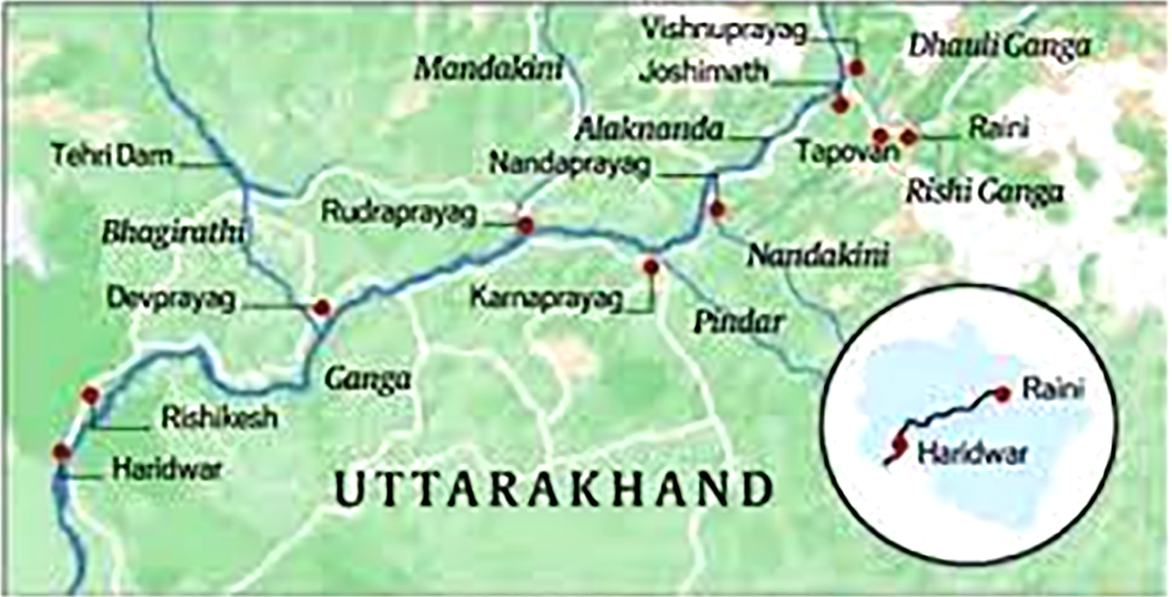Biodiversity & Environment
Vishnugad Pipalkoti Hydro Electric Project
- 31 Aug 2022
- 6 min read
For Prelims: Vishnugad Pipalkoti Hydro Electric Project, Alaknanda RIver, Ganga, Hydropower Projects in Uttrakhand, Climate Change.
For Mains: Challenges to Hydropower Projects in Himalayas.
Why in News?
Recently, the World Bank has agreed to look into environmental damage from the under-construction Vishnugad Pipalkoti Hydro Electric Project (VPHEP) on the Alaknanda River in Uttarakhand.
- The panel has considered the request for an enquiry after accepting the Complaints from 83 Local Communities.
What is the Geography of Alaknanda River?
- It is one of the headstreams of the Ganga.
- It rises at the confluence and feet of the Satopanth and Bhagirath glaciers in Uttarakhand.
- It meets the Bhagirathi River at Devprayag after which it is called the Ganga.
- Its main tributaries are the Mandakini, Nandakini, and Pindar rivers.
- The Alaknanda system drains parts of Chamoli, Tehri, and Pauri districts
- The Hindu pilgrimage center of Badrinath and the natural spring Tapt Kund lie along the banks of the Alaknanda River
- At Its origin, Lake Satopanth is a triangular lake located at a height of 4402 m and named after the Hindu trinity Lord Brahma, Lord Vishnu, and Lord Shiva.
- Panch Prayag: Five sites in Uttarakhand where five rivers merge into River Alaknanda to ultimately form the holy River Ganga is called Panch Prayag (in Hindi, 'panch' means five and 'prayag' means confluence).
- First, Alaknanda meets Dhauliganga river at Vishnuprayag, move on to Nandaprayag to meet Nandakini river then travels to Karnaprayag to join Pindar river. It unites with Nandakini river at Rudraprayag and joins the last and the final Bhagirathi river at Devprayag.
What are the Complaints?
- The project would destroy the ancient Laxmi Narayan Temple in Haat village.
- The temple is a cultural resource for the locals and is the source of their livelihood.
- Muck-dumping from the dam threatens the architecture of the temple walls, which is an ancient heritage site, the villagers claimed.
- The locals claimed to have a sacred bond with Laxmi Narayan Temple, which was allegedly established by Adi Shankaracharya in the 19th century.
- The residents are being forcefully relocated from their village.
- Some locals who refused to accept compensation and move to another place were removed from their homes while some were locked up by the police.
- The project has also not taken disasters caused by climate change and extreme weather events into account.
- A mid-day cloudburst in Kedarnath in 2013 and the Chamoli disaster of 2021 were also ignored.
What is VPHEP?
- The 444-MW VPHEP is being built by the Tehri Hydropower Development Corporation, a partially Centre-owned enterprise.
- The project is primarily funded by the World Bank and was sanctioned in 2011
- The hydropower project has been targeted to be completed by 30th June, 2023 at the cost of USD 922 million.
- The project will build a 65-meter diversion dam near Helang village in Chamoli district of Uttarakhand to create a small reservoir in the Alaknanda River.
What are the Hydro Power Projects in Uttarakhand?
- Tehri Stage 2: 1000 MW on Bhagirathi river
- Tapovan Vishnugadh: 520 MW on Dhauliganga river
- Vishnugadh Pipalkoti: 444 MW on Alaknanda river
- Singoli Bhatwari: 99 MW on Mandakini river
- Phata Bhuyang: 76 MW on Mandakini river
- Madhyamaheshwar: 15 MW on Madhyamaheshwar Ganga
- Kaliganga 2: 6 MW on Kaliganga river.
What are the Challenges to Hydropower Projects in Himalayas?
- Decreasing Stability:
- Glacier retreat and Permafrost Thaw are projected to decrease the stability of mountain slopes and increase the number and area of glacier lakes.
- Permafrost Thawing is the release of the powerful greenhouse gas methane into the atmosphere, which contributes to further warming in a reinforcing feedback loop.
- Glacier retreat and Permafrost Thaw are projected to decrease the stability of mountain slopes and increase the number and area of glacier lakes.
- Climate Change:
- Climate change has driven erratic weather patterns like increased snowfall and rainfall.
- The thermal profile of ice is increasing, which means that the temperature of ice that used to range from -6 to -20 degree C, is now -2 degree C, making it more susceptible to melting.
- Increase in Calamitic Instances:
- With increased instances of cloudbursts, and intense spells of rainfall and avalanches, residents of the region are also placed at increased risk of loss of lives and livelihood.
Way Forward
- It is recommended that there should be no hydropower development beyond an elevation of 2,200 metre in the Himalayan region.
- Considering population growth and required industrial and infrastructure growth, the government should be serious in the development of hydro power which is essential for the sustainable growth of the economy, but in a more ecological manner.
UPSC Civil Services Examination Previous Year Question (PYQ)
Q. On which one of the following rivers is the Tehri Hydropower Complex located? (2008)
(a) Alaknanda
(b) Bhagirathi
(c) Dhauliganga
(d) Mandakini
Ans: (b)
Q. Where are Tapovan and Vishnugarh Hydroelectric Projects located? (2008)
(a) Madhya Pradesh
(b) Uttar Pradesh
(c) Uttarakhand
(d) Rajasthan
Ans: (c)







